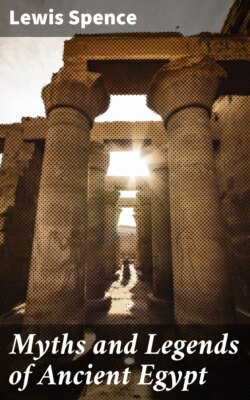Читать книгу Myths and Legends of Ancient Egypt - Lewis Spence - Страница 54
На сайте Литреса книга снята с продажи.
A New Osirian Theory
ОглавлениеWe must also take into brief consideration his personification of Ra, whom he meets, blends with, and under whose name he nightly sails through his own dominions. This would seem like the fusion of a sun and moon myth; the myth of the sun travelling nightly beneath the earth fused with that of the moon's nocturnal journey across the vault of heaven. A moment's consideration will show how this fusion took place. Osiris was a moon-god. That circumstance accounts for one half of the myth; the other half is to be accounted for as follows: Ra, the sun-god, must perambulate the underworld at night if he is to appear on the fringes of the east in the morning. But Osiris as a lunar deity, and perhaps as the older god, as well as in his character as god of the underworld, is already occupying the orbit he must trace. The orbits of both deities are fused in one, and there would appear to be some proof of this in the fact that, in the realm of Seker, Afra (or Ra-Osiris) changes the direction of his journey from north to south to a line due east toward the mountains of sunrise. The fusion of the two myths is quite a logical one, as the moon during the night travels in the same direction as the sun has taken during the day—that is, from east to west.
It will readily be seen how Osiris came to be regarded not only as god and judge of the dead, but also as symbolical of the resurrection of the body of man. Sir James Frazer lays great stress upon a picture of Osiris in which his body is shown covered with sprouting shoots of corn, and he seems to be of opinion that this is positive evidence that Osiris was a corn-god. In our view the picture is simply symbolical of resurrection. The circumstance that Osiris is represented in the picture as in the recumbent position of the dead lends added weight to this supposition. The corn-shoot is a world-wide symbol of resurrection. In the Eleusinian mysteries a shoot of corn was shown to the neophytes as typical of physical rebirth, and a North American Indian is quoted by Loskiel, one of the Moravian Brethren, as having spoken: "We Indians shall not for ever die. Even the grains of corn we put under the earth grow up and become living things." Among the Maya of Central America, as well as among the Mexicans, the maize-goddess has a son, the young, green, tender shoot of the maize plant, who is strongly reminiscent of Horus, the son of Osiris, and who may be taken as typical of bodily resurrection. Later the vegetation myth clustering round Osiris was metamorphosed into a theological tenet regarding human resurrection, and Osiris was believed to have been once a human being who had died and had been dismembered. His body, however, was made whole again by Isis, Anubis and Horus acting upon the instructions of Thoth. A good deal of magical ceremony appears to have been mingled with the process, and this in turn was utilized in the case of every dead Egyptian by the priests in connexion with the embalmment and burial of the dead in the hope of resurrection. Osiris, however, was regarded as the principal cause of human resurrection, and he was capable of giving life after death because he had attained to it. He was entitled 'Eternity and Everlastingness,' and he it was who made men and women to be born again. This conception of resurrection appears to have been in vogue in Egypt from very early times. The great authority upon Osiris is the Book of the Dead, which might well be called the 'Book of Osiris,' and in which are recounted his daily doings and his nightly journeyings in his kingdom of the underworld.
